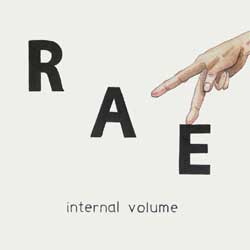Reviews in this Issue:
Internal Volume, Rae
Wabi Sabi, Tipton Sax Quartet & Drums
One challenge of life over the past few months of the global pandemic has been finding ways to navigate through the noise and uncertainty of everyday life, to stay grounded and focused on a constant. It is an almost daily quest to sift through the unceasing stimuli of human existence in 2020 to find a place to calm the mind and capture the increasingly nervous energy permeating our collective realities. Fitting, in this context, for local avant-jazz trio, Rae, to put out their first album, the self-released Internal Volume. The individuals of Rae have not only an academic understanding of jazz, but also a deep emotional and instinctual relationship with the artform. Working as a unit, bassist Abbey Blackwell, guitarist Ronan Delisle, and drummer Evan Woodle give an examination of atmospheric quietude centered within a context of complex disjointedness.
Each track on Internal Volume is identified by a number instead of a name. For example, the seventh track on the album is “03”, the fourth track is “15,” and so on. This allows for the listener to interpret the music based not on clues gleaned by song titles in the traditional sense, but instead through free association based on the soundscapes the music itself creates. On first listen the collection of songs presents a nervous, pensive atmosphere. The steady, measured bass serves as a counterpoint to the rolling, snare-heavy drums, creating a polyrhythm that pulls in many directions, while the guitar speaks over the percussive foundation, playing a game of cat-and-mouse with the listener. However, once the motif is snagged a world of different images and emotions is unraveled.
The ability of the members of Rae to play off each other and move toward a deeply textured, multifaceted, unified whole is undeniable. Rae guides us on their musical journey through their varied twists and turns, presenting new paths and valleys, allowing space for us to create new meaning along the way. The music is itself an aural representation of calm amidst chaos. Internal Volume exhorts the listener to listen to the chaos inside and orient the self toward a steady calm. –Grant Grays
Impermanence, imperfection, and incompleteness are qualities captured by the elusive Japanese aesthetic concept of “wabi-sabi.” Recording since 1988, the Tiptons Saxophone Quartet has, over the years, been anything but ephemeral. Though well-rehearsed, their latest release embraces the roughhewn and raucous, delivering far cries and funky breakdowns within polished arrangements.
Kudos to drummer Robert Kainar, who keeps the heat on under the concoctions of saxophonists Amy Denio, Jessica Lurie, Sue Orfield, and Tina Richerson, from the mardis gras blowout of “Jouissance” to the boom-slap drive of “Working Song.” The quartet’s thick, interlocking melodies are nothing accidental; like the house band of an infernal carnival, the five bring Balkan vibes to minor marches such as “Root Dance” and fiercely testifying solos to the steady snap of “Memory Bait.”
Each knows their part, and through their collaboration and communication, the Tiptons’ are positively upbeat. On “El Gran Orinador,” they slap on a lurching salsa, Richerson’s baritone bass lines playing off the soulful vibrato of the latter. Their solid and confident reed technique, reminiscent of the Latin American brass tradition, weightlessly holds up this kind of arrangement, audible as well on the swelling drift of the slower, almost neo-classical “Torqueing of the Spheres.”
The ensemble’s use of sung voice also stands out, pulling in and out of the instrumental texture. It really pops in an all-voice break at the second part of the high tempo shuffle, “Moadl Joadl,” where the inventive use of yodeling and other vocal techniques, along with hocketing claps, infectiously matches the group’s rhythmic eclecticism.
As if a ghostly parade suddenly appeared tramping through the streets and alleys of the city, the melodies of Wabi Sabi summon a grandiose fanfare of the everyday. It’s a blustery march: cheerful, mournful, graceful, full of wild cries and incantations, but exuberant, ample, and even by beauty, unresolved.–Ian Gwin







